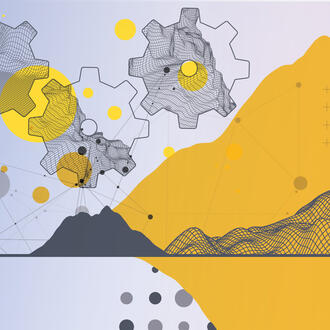Credit: Bin Wang / IR_Stone / iStock
The average commuter in U.S. cities spends about 200 hours per year in their car. More than three-quarters of people drive alone. These behaviors are costly for many reasons — environmental, infrastructural, and psychological — and they are hard to influence.
“Researchers in behavioral science have looked at nudges to get people to drive less and walk or take public transit more, but these interventions typically have minimal results,” said Rachit Dubey, a postdoctoral research fellow at MIT Sloan who studies behavioral science and climate change. “What if instead we got people to clearly imagine their life in a less car-dependent society? Maybe people just don’t know how good it could be.”
Following this intuition, Dubey, in collaboration with MIT Sloan marketing professor and Princeton University’s Thomas L. Griffiths and Mathew D. Hardy, used artificial intelligence to create visualizations of what a less car-centric city might look like.
Credit: Rahul Bhui, Rachit Dubey, Thomas L. Griffiths, and Mathew D. Hardy, "AI-generated visuals of car-free US cities help improve support for sustainable policies," Feb. 23, 2024.
When provided with this vision of the future, people were far more likely to support sustainable urban development, giving researchers hope of reaching consensus for green projects even across political party lines.
The influence of imagination
The researchers ran two experiments in which roughly 3,100 U.S.-based participants recruited online were presented with a hypothetical municipal bill that would invest $500 billion in improving a city’s public transportation and walkability while halving car dependency.
Participants were then shown images from Google Maps of heavily trafficked roadways, like I-35 outside of Austin, Texas, before being randomly assigned to one of three groups.
The first group simply read a sentence that described how the investment would be used to transform the image they had just seen. The second group, the visual control, was shown a cartoonlike illustration of what the space might look like if the bill were to pass.
The third group saw a more fully realized, AI-generated photographic image of the proposed space, created by DALL-E 2, that showed how the bill might be used to develop things like bike lanes and greenways in places currently occupied by highways.
Participants were then asked to indicate whether they supported or opposed the bill on a 10-point scale, where 1 indicated “strongly oppose” and 10 indicated “strongly support.” The results:
- Those who only read a sentence about the bill’s potential outcomes ranked their support at 5.4, on average.
- Participants who saw a cartoon-like illustration ranked it at 6.
- Those who saw the AI-generated visualizations ranked their support at 6.4.
Related Articles
“In general, the intervention with AI-generated images moved people a little bit toward being more supportive of the bill — and sometimes that small bump is all you need,” Dubey said. “If you’re gathering signatures on a petition, for instance, that could be the crucial difference between something passing and failing.”
Of particular note, the effect of the AI-generated images was strongest among participants who identified as Republicans. Their willingness to sign the petition roughly doubled compared with that of participants in the other two conditions.
These results come at a time when urban planning that centers sustainability is an increasingly polarizing topic. With the shift in sentiment not only cutting across party lines but proving strongest among conservatives, Dubey described himself as “cautiously optimistic.”
A visual approach to promoting a greener future
The use of AI to generate the images was, in some ways, incidental to the results. It’s possible that other approaches not rooted in AI, like virtual reality or carefully produced videos, could be even more persuasive through deeper immersion.
More than anything, AI presents an inexpensive way to create a variety of imagined futures, Dubey said. Given how cheaply and rapidly AI can generate images like the ones the researchers used, this could be a potent urban planning tool in the future.
Regardless of what approach is used, though, helping people to visualize and imagine a greener future might be a promising tool for overcoming the stalemate over U.S. climate policy.
“One way to approach climate policy is by trying to educate skeptics on the threat of climate change in the hopes that they will revise their beliefs and come around to support the issues,” Dubey said. “That’s a noble goal, but trying to convince someone to change their worldview is a tough problem to solve.”
This research shows the value of simply letting people see some of the potential immediate impacts of having fewer cars versus just telling them about the environmental benefits of less driving. Whether the person cares about climate change or not, they can see the personal appeal of a greener and more walkable city.
“They could be outspoken critics of the science of climate change and still vote for a policy that reduces emissions because they want to live in the kind of neighborhood they see,” Dubey said.
The next step in this work will be to move it from a hypothetical bill to a field experiment, in which people sign real petitions or vote on real policies. “Maybe this small intervention could help organizations that are trying to create less car-reliant neighborhoods or trying to stop the expansion of highways,” Dubey said. “We want to see whether this effect holds when we go out in the world.”




